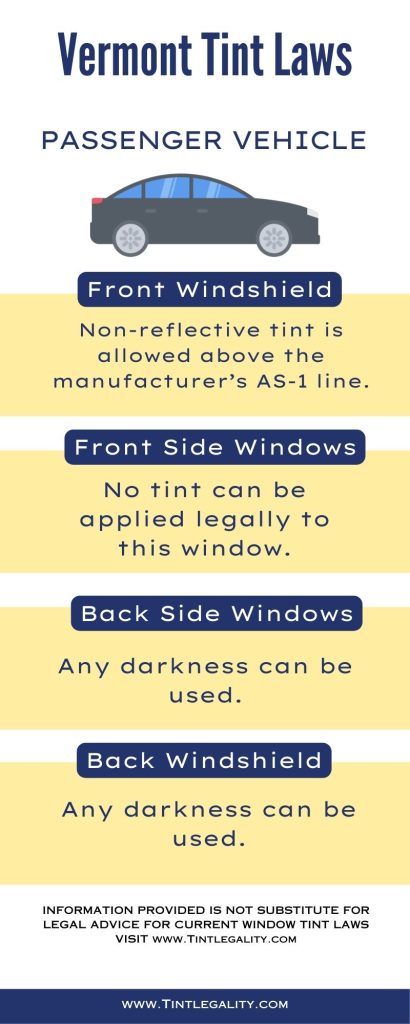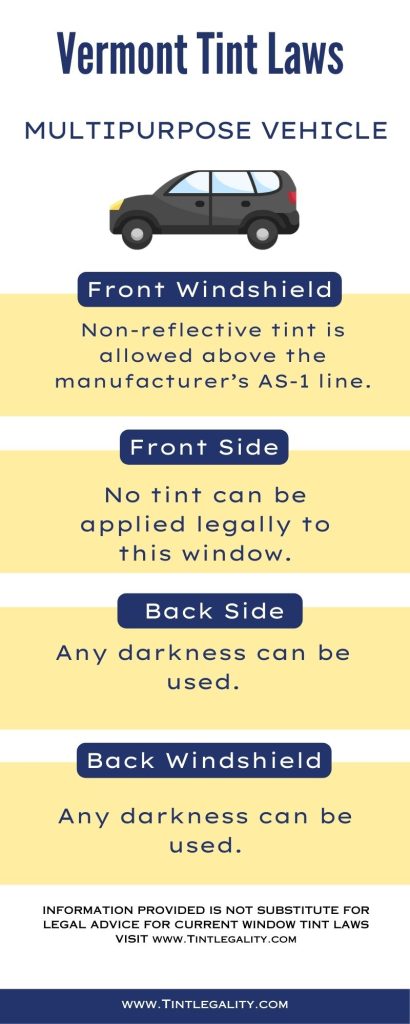Vermont tint laws were enacted in 1984 to regulate the use of window tint in vehicles.
These laws are primarily concerned with the percentage of visible light transmission (VLT), which is the amount of light that can pass through the window tint.
The restrictions are different for sedans, SUVs, and vans.
Regulations Regarding Window Tint in Vermont
Vermont has specific regulations for different types of windows on vehicles.
Understanding these can help avoid any potential run-ins with law enforcement agencies.
| Vehicle Type | Windshield | Front Side Windows | Back Side Windows | Rear Window |
|---|---|---|---|---|
| Sedans | Non-reflective tint allowed above the manufacturer’s AS-1 line | Tint can be applied, but the darkness level is not specified | Tint darkness is not specified | Tint darkness is not specified |
| SUVs and vans | Non-reflective tint allowed above the manufacturer’s AS-1 line | Tint can be applied, but the darkness level is not specified | Tint darkness is not specified | Tint darkness is not specified |
Windshield
In Vermont, the use of non-reflective tint is allowed along the top of the windshield above the manufacturer’s AS-1 line.
It is crucial to remember that any form of tint below this line is not legal.
Front Side Windows
The law stipulates that front side windows can have a tint, but the darkness level is not specifically defined.
Hence, it’s imperative to make sure any tint applied is not exceedingly dark, which could potentially impede vision and attract penalties.
Back Side Windows
The backside windows’ tint darkness is also not defined by Vermont laws.
However, a general rule of thumb is to avoid excessively dark tints that block out too much light, impairing vision and safety.
Rear Window
The rear window, similar to the backside windows, does not have a specified darkness level in the Vermont tint laws.
Still, it’s recommended to avoid extremely dark tints for safety reasons.


Additional Regulations
Apart from the tint darkness levels, there are a few other rules and regulations that Vermont drivers need to be aware of.
Reflection
In Vermont, windows can have a mirrored or metallic appearance.
This is to reflect incoming light and reduce heat and glare.
However, Vermont window tint law permits only a certain level of reflection.
Medical Exemptions
Vermont tinting law permits certain medical exemptions which allow the use of darker tints.
These are allowed only if they are required for a medical condition and with proper documentation.
Color Restrictions
Vermont prohibits the usage of certain tint colors.
It’s essential to be aware of these color restrictions to stay within the bounds of the law.
Side Mirrors
The state law requires dual side mirrors if the back window is tinted. This is to ensure adequate visibility for the driver despite the tinted rear window.
Exceptions to Legal Limits
There might be exceptions to the legal limits on window tints. For instance, certain commercial vehicles or those used for specific purposes may have different regulations.
Penalties for Breaking the Law
Breaking the Vermont tint laws can attract penalties, which can include fines and other consequences.
Fines
First Conviction
For the first conviction, the fine is usually a moderate amount. This is to serve as a warning to the driver about the infraction.
Second Conviction
A second conviction typically attracts a higher fine. This is because repeat offenses are viewed more seriously.
Third Conviction
A third conviction would warrant an even higher fine. The objective is to deter future violations and ensure compliance with the law.
Other Penalties
Apart from fines, other penalties can include community service or mandatory attendance at traffic safety courses.
Penalties for Non-Compliance
For non-compliance with these laws, drivers can face additional penalties, such as points on their licenses or increased insurance premiums.
Always remember that Vermont tinting laws and regulations may be interpreted differently by county and place of residence.
Always double-check this information with your local DMV or law enforcement authorities.
Keeping within the legal limits of Vermont tint laws is important, not just to avoid penalties but also to ensure safety.
Being informed and adhering to these laws helps create a safer driving environment for everyone on the road.
References:
https://en.wikipedia.org/wiki/Vermont
https://legislature.vermont.gov/statutes/chapter/23/013
https://dmv.vermont.gov/sites/dmv/files/documents/VN-022-Window_Tint.pdf